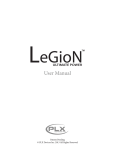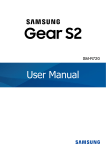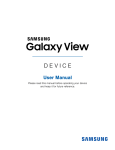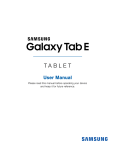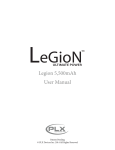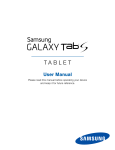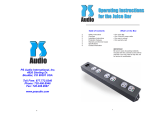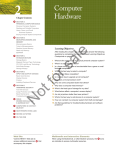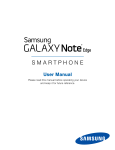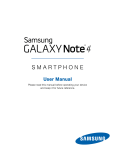Download SM-N920T Health and Safety & Warranty Guide
Transcript
M O B I L E
P H O N E
Health and Safety &
Warranty Guide
Please read this manual before
operating your device and keep
it for future reference.
Warning! This product contains chemicals
known to the State of California to
cause cancer and reproductive
toxicity. For more information, please
call 1-800-SAMSUNG (726-7864).
Intellectual Property
All Intellectual Property, as defined below,
owned by or which is otherwise the property of
Samsung or its respective suppliers relating to
the SAMSUNG Phone, including but not limited
to, accessories, parts, or software relating
thereto (the “Phone System”), is proprietary to
Samsung and protected under federal laws,
state laws, and international treaty provisions.
Intellectual Property includes, but is not limited
to, inventions (patentable or unpatentable),
patents, trade secrets, copyrights, software,
computer programs, and related
documentation and other works of authorship.
You may not infringe or otherwise violate the
rights secured by the Intellectual Property.
Moreover, you agree that you will not (and will
not attempt to) modify, prepare derivative
works of, reverse engineer, decompile,
disassemble, or otherwise attempt to create
source code from the software. No title to or
ownership in the Intellectual Property is
transferred to you. All applicable rights of the
Intellectual Property shall remain with
SAMSUNG and its suppliers.
N920T_EN_HS_PS_OFC_062915_R3
Open Source Software
Some software components of this product
incorporate source code covered under GNU
General Public License (GPL), GNU Lesser
General Public License (LGPL), OpenSSL
License, BSD License and other open source
licenses. To obtain the source code covered
under the open source licenses, please visit:
http://opensource.samsung.com.
Disclaimer of Warranties;
Exclusion of Liability
EXCEPT AS SET FORTH IN THE EXPRESS
WARRANTY CONTAINED ON THE WARRANTY
PAGE ENCLOSED WITH THE PRODUCT, THE
PURCHASER TAKES THE PRODUCT "AS IS",
AND SAMSUNG MAKES NO EXPRESS OR
IMPLIED WARRANTY OF ANY KIND
WHATSOEVER WITH RESPECT TO THE
PRODUCT, INCLUDING BUT NOT LIMITED TO
THE MERCHANTABILITY OF THE PRODUCT OR
ITS FITNESS FOR ANY PARTICULAR PURPOSE
OR USE; THE DESIGN, CONDITION OR QUALITY
OF THE PRODUCT; THE PERFORMANCE OF THE
PRODUCT; THE WORKMANSHIP OF THE
PRODUCT OR THE COMPONENTS CONTAINED
THEREIN; OR COMPLIANCE OF THE PRODUCT
WITH THE REQUIREMENTS OF ANY LAW, RULE,
SPECIFICATION OR CONTRACT PERTAINING
THERETO. NOTHING CONTAINED IN THE
INSTRUCTION MANUAL SHALL BE CONSTRUED
TO CREATE AN EXPRESS OR IMPLIED
WARRANTY OF ANY KIND WHATSOEVER WITH
RESPECT TO THE PRODUCT. IN ADDITION,
SAMSUNG SHALL NOT BE LIABLE FOR ANY
DAMAGES OF ANY KIND RESULTING FROM THE
PURCHASE OR USE OF THE PRODUCT OR
ARISING FROM THE BREACH OF THE EXPRESS
WARRANTY, INCLUDING INCIDENTAL, SPECIAL
OR CONSEQUENTIAL DAMAGES, OR LOSS OF
ANTICIPATED PROFITS OR BENEFITS.
Modification of Software
SAMSUNG IS NOT LIABLE FOR PERFORMANCE
ISSUES OR INCOMPATIBILITIES CAUSED BY
YOUR EDITING OF REGISTRY SETTINGS, OR
YOUR MODIFICATION OF OPERATING SYSTEM
SOFTWARE.
USING CUSTOM OPERATING SYSTEM
SOFTWARE MAY CAUSE YOUR DEVICE AND
APPLICATIONS TO WORK IMPROPERLY. YOUR
CARRIER MAY NOT PERMIT USERS TO
DOWNLOAD CERTAIN SOFTWARE, SUCH AS
CUSTOM OS.
Samsung KNOX
Samsung Knox™ is Samsung’s security
platform and is a mark for a Samsung device
tested for security with enterprise use in mind.
Additional licensing fee may be required. For
more information about Knox, please refer
to: www.samsung.com/us/knox. [030115]
Samsung Electronics
America (SEA), Inc
Address:
85 Challenger Road
Ridgefield Park,
New Jersey 07660
Phone:
1-800-SAMSUNG (726-7864)
Internet Address:
www.samsung.com
©2015 Samsung Electronics America, Inc.
Samsung is a registered trademark of
Samsung Electronics Co., Ltd.
Do you have questions about your Samsung
Mobile Device?
For 24 hour information and assistance, we
offer a new FAQ/ARS System (Automated
Response System) at:
www.samsung.com/us/support
Legal Information
Important legal information can be accessed in
writing on the mobile device or on
samsung.com.
Read this information before using your mobile
device.
Samsung Limited Warranty - This product is
covered under the applicable Samsung
Limited Warranty. Full written terms and
detailed information about the warranty and
obtaining service are available on the device
at: Settings ➔ About device ➔ Legal
Information ➔ Samsung legal or at
samsung.com.
The online version of the Health/Safety
and Warranty guide for your device can be
found at:
English:
www.samsung.com/us/Legal/Phone-HSGuide
Spanish:
www.samsung.com/us/Legal/Phone-HSGuide-SP
Location of Legal Information on the device:
Health and Safety Information
• Settings ➔ About device ➔ Legal
information ➔ Samsung legal ➔ Health
and Safety
Warranty
• Settings ➔ About device ➔ Legal
information ➔ Samsung legal ➔ Warranty
EULA
• Settings ➔ About device ➔ Legal
information ➔ Samsung legal ➔ End User
License Agreement
Table of Contents
Section 1: Health and Safety
Information ....................................... 2
Specific Absorption Rate (SAR)
Certification Information . . . . . . . . . . 2
FCC Part 15 Information to User . . . . . . 5
Commercial Mobile Alerting System
(CMAS) . . . . . . . . . . . . . . . . . . . . . . . 6
Samsung Mobile Products and
Recycling . . . . . . . . . . . . . . . . . . . . . 7
GPS & AGPS . . . . . . . . . . . . . . . . . . . . . 9
Emergency Calls . . . . . . . . . . . . . . . . . 11
FCC Hearing Aid Compatibility (HAC)
Regulations for Wireless Devices . . . 12
Restricting Children's Access to
Your Mobile Device . . . . . . . . . . . . . 16
Section 2: Online Legal
Information ..................................... 17
End User License Agreement for
Software . . . . . . . . . . . . . . . . . . . . . 17
Health/Safety and Warranty Guide . . . . 17
Index ................................................ 18
1
Section 1: Health and
Safety Information
This section outlines the safety precautions
associated with using your phone. The terms
“mobile device” or “cell phone” are used in
this section to refer to your phone. Read this
information before using your mobile device.
Caution! Exercise care when using the card
removal tool to eject an internal card
slot.
This device is capable of operating in Wi-Fi™
mode in the 2.4 and 5 GHz bands. The FCC
requires that devices operating within
5.15-5.25 GHz may only be used indoors, not
outside, in order to avoid interference with
Mobile Satellite Services (MSS). Therefore, this
device is restricted from being used outdoors
when operating in frequencies between
5.15-5.25 GHz.
Specific Absorption Rate
(SAR) Certification
Information
Your wireless device is a radio transmitter and
receiver. It is designed and manufactured not
to exceed the exposure limits for Radio
Frequency (RF) energy set by the Federal
Communications Commission (FCC) of the U.S.
Government.
Health and Safety Information
2
These FCC RF exposure limits are derived from
the recommendations of two expert
organizations: the National Council on
Radiation Protection and Measurement (NCRP)
and the Institute of Electrical and Electronics
Engineers (IEEE). In both cases, the
recommendations were developed by
scientific and engineering experts drawn from
industry, government, and academia after
extensive reviews of the scientific literature
related to the biological effects of RF energy.
The RF exposure limit set by the FCC for
wireless mobile phones employs a unit of
measurement known as the Specific
Absorption Rate (SAR). The SAR is a measure
of the rate of absorption of RF energy by the
human body expressed in units of watts per
kilogram (W/kg). The FCC requires wireless
phones to comply with a safety limit of 1.6
watts per kilogram (1.6 W/kg).
The FCC SAR limit incorporates a substantial
margin of safety to give additional protection
to the public and to account for any variations
in measurements.
SAR tests are conducted using standard
operating positions accepted by the FCC with
the phone transmitting at its highest certified
power level in all tested frequency bands.
Although the SAR is determined at the highest
certified power level, the actual SAR level of
the phone while operating can be well below
the maximum reported value. This is because
the phone is designed to operate at multiple
power levels so as to use only the power
3
required to reach the network. In general, the
closer you are to a wireless base station
antenna, the lower the power output of the
device.
Before a new model device is available for sale
to the public, it must be tested and certified to
the FCC that it does not exceed the SAR limit
established by the FCC. Tests for each model
phone are performed in positions and locations
(e.g. at the ear and worn on the body) as
required by the FCC. For body-worn operation,
this device has been tested and meets FCC RF
exposure guidelines when used with an
accessory that contains no metal and that
positions the mobile device a minimum of
1.5 cm from the body. Use of other
accessories may not ensure compliance with
FCC RF exposure guidelines. The FCC has
granted an Equipment Authorization for this
mobile device with all reported SAR levels
evaluated as in compliance with the FCC RF
exposure guidelines.
This device has a FCC ID number:
A3LSMN920T [Model Number: SM-N920T]
and the specific SAR levels for this device can
be found at the following FCC
website:www.fcc.gov/oet/ea/.
The SAR information for this device can also
be found on Samsung’s website:
www.samsung.com/sar.
SAR information on this and other model
devices can be accessed online on the FCC's
website through
http://transition.fcc.gov/oet/rfsafety/sar.html. To
Health and Safety Information
4
find information that pertains to a particular
model, this site uses the device FCC ID
number which is usually printed somewhere
on the case of the device. Sometimes it may
be necessary to remove the battery pack to
find the number. Once you have the FCC ID
number for a particular device, follow the
instructions on the website and it should
provide values for typical or maximum SAR for
a particular phone. Additional SAR information
can also be obtained at
www.fcc.gov/encyclopedia/specific-absorptionrate-sar-cellular-telephones.
FCC Part 15 Information to
User
Pursuant to part 15.21 of the FCC Rules, you
are cautioned that changes or modifications
not expressly approved by Samsung could void
your authority to operate the device.
This device complies with part 15 of the FCC
Rules. Operation is subject to the following two
conditions: (1) This device may not cause
harmful interference, and (2) this device must
accept any interference received, including
interference that may cause undesired
operation.
Note: This equipment has been tested and
found to comply with the limits for a Class B
digital device, pursuant to part 15 of the FCC
Rules. These limits are designed to provide
reasonable protection against harmful
interference in a residential installation. This
equipment generates, uses and can radiate
5
radio frequency energy and, if not installed
and used in accordance with the instructions,
may cause harmful interference to radio
communications.
However, there is no guarantee that
interference will not occur in a particular
installation. If this equipment does cause
harmful interference to radio or television
reception, which can be determined by turning
the equipment off and on, the user is
encouraged to try to correct the interference
by one or more of the following measures:
• Reorient or relocate the receiving antenna.
• Increase the separation between the equipment
and receiver.
• Connect the equipment into an outlet on a circuit
different from that to which the receiver is
connected.
• Consult the dealer or an experienced radio/TV
technician for help.
Commercial Mobile Alerting
System (CMAS)
This device is designed to receive wireless
emergency alerts from the Commercial Mobile
Alerting System ("CMAS"; which may also be
known as the Personal Localized Alerting
Network ("PLAN")). If your wireless provider
has chosen to participate in CMAS/PLAN,
alerts are available while in the provider's
coverage area. If you travel outside your
provider's coverage area, wireless emergency
Health and Safety Information
6
alerts may not be available. For more
information, please contact your wireless
provider.
Samsung Mobile Products
and Recycling
Samsung cares for the environment and
encourages its customers to recycle Samsung
mobile devices and genuine Samsung
accessories.
Proper disposal of your mobile device and its
battery is not only important for safety, it
benefits the environment.
Batteries must be recycled or disposed of
properly.
Note: Dispose of unwanted electronics through
an approved recycler.
We've made it easy for you to recycle your old
Samsung mobile device by working with
respected take-back companies in every state
in the country.
Note: Most carriers will provide a take-back
option for products to be properly
disposed when purchasing new products.
For battery recycling,
go to call2recycle.org
or call 1-800-822-8837.
Drop It Off
You can drop off your Samsung-branded
mobile device and batteries for recycling at
7
one of our numerous Samsung Recycling
Direct (SM) locations.
Note: Samsung-branded devices and batteries
will be accepted at these locations for no
fee.
To find the nearest recycling location, go to
any of the following:
• www.samsung.com/recyclingdirect or call
1-877-278-0799.
• PLUG-IN to eCYCLING with EPA:
www.call2recycle.org/
Mail It In
The Samsung Mobile Take-Back Program
will provide Samsung customers with a
free recycling mailing label.
For more information, go to:
https://pages.samsung.com/recycling/index.jsp
and follow the on-screen instructions or
call 1-800-822-8837.
Follow local regulations regarding
disposal of mobile devices and batteries
Dispose of your mobile device and batteries in
accordance with local regulations. In some
areas, the disposal of these items in household
or business trash may be prohibited. Help us
protect the environment - recycle!
Warning! Never dispose of batteries in a fire
because they may explode.
Health and Safety Information
8
GPS & AGPS
Certain Samsung mobile devices can use a
Global Positioning System (GPS) signal for
location-based applications. A GPS uses
satellites controlled by the U.S. Government
that are subject to changes implemented in
accordance with the Department of Defense
policy and the 2008 Federal Radio navigation
Plan (FRP). Changes may affect the
performance of location-based technology on
your mobile device.
Certain Samsung mobile devices can also use
an Assisted Global Positioning System (AGPS),
which obtains information from the cellular
network to improve GPS performance. AGPS
uses your wireless service provider's network
and therefore airtime, data charges, and/or
additional charges may apply in accordance
with your service plan. Contact your wireless
service provider for details.
Your Location
Location-based information includes
information that can be used to determine the
approximate location of a mobile device.
Mobile devices which are connected to a
wireless network transmit location-based
information. Additionally, if you use
applications that require location-based
information (e.g. driving directions), such
applications transmit location-based
information. The location-based information
may be shared with third-parties, including
9
your wireless service provider, applications
providers, Samsung, and other third-parties
providing services.
Use of AGPS in Emergency Calls
When you make an emergency call, the
cellular network may activate AGPS
technology in your mobile device to tell the
emergency responders your approximate
location.
AGPS has limitations and might not work in
your area. Therefore:
• Always tell the emergency responder your
location to the best of your ability; and
• Remain on the mobile device for as long as the
emergency responder instructs you.
Navigation
Maps, directions, and other navigation-data,
including data relating to your current location,
may contain inaccurate or incomplete data,
and circumstances can and do change over
time. In some areas, complete information
may not be available. Therefore, you should
always visually confirm that the navigational
instructions are consistent with what you see
before following them. All users should pay
attention to road conditions, closures, traffic,
and all other factors that may impact safe
driving or walking. Always obey posted road
signs.
Health and Safety Information
10
Emergency Calls
This mobile device, like any wireless mobile
device, operates using radio signals, wireless
and landline networks, as well as
user-programmed functions, which cannot
guarantee connection in all conditions, areas,
or circumstances.
Therefore, you should never rely solely on any
wireless mobile device for essential
communications (medical emergencies, for
example). Before traveling in remote or
underdeveloped areas, plan an alternate
method of contacting emergency services
personnel. Remember, to make or receive any
calls, the mobile device must be switched on
and in a service area with adequate signal
strength.
Emergency calls may not be possible on all
wireless mobile device networks or when
certain network services and/or mobile device
features are in use. Check with local service
providers. If certain features are in use (call
blocking, for example), you may first need to
deactivate those features before you can make
an emergency call. Consult your User Manual
and your local cellular service provider. When
making an emergency call, remember to give
all the necessary information as accurately as
possible. Remember that your mobile device
may be the only means of communication at
the scene of an accident; do not cut off the call
until given permission to do so.
11
To make an emergency call:
1. If the mobile device is not on, switch it
on.
2. Open your phone dialer.
3. Enter the emergency number for your
present location (for example, 911 or
other official emergency number), then
tap Call/Send. Emergency numbers vary
by location.
FCC Hearing Aid
Compatibility (HAC)
Regulations for Wireless
Devices
The U.S. Federal Communications Commission
(FCC) has established requirements for digital
wireless mobile devices to be compatible with
hearing aids and other assistive hearing
devices.
When individuals employing some assistive
hearing devices (hearing aids and cochlear
implants) use wireless mobile devices, they
may detect a buzzing, humming, or whining
noise. Some hearing devices are more
immune than others to this interference noise,
and mobile devices also vary in the amount of
interference they generate.
The wireless telephone industry has developed
a rating system for wireless mobile devices to
assist hearing device users find mobile
devices that may be compatible with their
hearing devices. Not all mobile devices have
Health and Safety Information
12
been rated. Mobile devices that are rated have
the rating on their box or a label located on the
box.
The ratings are not guarantees. Results will
vary depending on the user's hearing device
and hearing loss. If your hearing device
happens to be vulnerable to interference, you
may not be able to use a rated mobile device
successfully. Trying out the mobile device with
your hearing device is the best way to evaluate
it for your personal needs.
M-Ratings: Wireless mobile devices rated M3
or M4 meet FCC requirements and are likely to
generate less interference to hearing devices
than mobile devices that are not labeled. M4 is
the better/higher of the two ratings. M-ratings
refer to enabling acoustic coupling with
hearing aids that do not operate in telecoil
mode.
T-Ratings: Mobile devices rated T3 or T4 meet
FCC requirements and are likely to generate
less interference to hearing devices than
mobile devices that are not labeled. T4 is the
better/higher of the two ratings. T-ratings refer
to enabling inductive coupling with hearing
aids operating in telecoil mode.
Hearing devices may also be rated. Your
hearing aid manufacturer or hearing health
professional may help you find this rating.
Higher ratings mean that the hearing device is
relatively immune to interference noise.
13
Under the current industry standard, American
National Standards Institute (ANSI) C63.19, the
hearing aid and wireless mobile device rating
values are added together to indicate how
usable they are together. For example, if a
hearing aid meets the M2 level rating and the
wireless mobile device meets the M3 level
rating, the sum of the two values equals M5.
Under the standard, this should provide the
hearing aid user with normal use while using
the hearing aid with the particular wireless
mobile device. A sum of 6 or more would
indicate excellent performance.
However, these are not guarantees that all
users will be satisfied. T ratings work similarly.
M3
+
M2
=
5
T3
+
T2
=
5
The HAC rating and measurement procedure
are described in the American National
Standards Institute (ANSI) C63.19 standard.
HAC for Newer Technologies
This phone has been tested and rated for use
with hearing aids for some of the wireless
technologies that it uses. However, there may
Health and Safety Information
14
be some newer wireless technologies used in
this phone that have not been tested yet for
use with hearing aids.
It is important to try the different features of
this phone thoroughly and in different
locations, using your hearing aid or cochlear
implant, to determine if you hear any
interfering noise. Consult your service provider
or the manufacturer of this phone for
information on hearing aid compatibility. If you
have questions about return or exchange
policies, consult your service provider or
phone retailer.
Caution! Some applications or prolonged usage
may increase device temperature.
Prolonged skin contact with a device
that is hot to the touch may produce
skin discomfort or redness, or
low-temperature burns. If the device
feels hot to the touch, discontinue use
and close all applications or turn off
the device until it cools. Always ensure
that the device has adequate
ventilation and air flow. Covering the
device with bedding, your body, thick
clothing or any other materials that
significantly affect air flow may affect
the performance of the phone and
poses a possible risk of fire or
explosion, which could lead to serious
bodily injuries or damage to property.
15
Restricting Children's
Access to Your Mobile Device
Your mobile device is not a toy. Do not allow
children to play with it because they could hurt
themselves and others, damage the mobile
device, or make calls that increase your
mobile device bill.
Keep the mobile device and all its parts and
accessories out of the reach of small children.
Health and Safety Information
16
Section 2: Online Legal
Information
SAMSUNG ELECTRONICS AMERICA, INC.
(“SAMSUNG”) warrants that SAMSUNG’s
devices and accessories (“Products”) are free
from defects in material and workmanship
under normal use and service.
Samsung Electronics America, Inc.
85 Challenger Road
Ridgefield Park, New Jersey 07660
Phone: 1-800-SAMSUNG (726-7864)
End User License Agreement
for Software
The EULA for this device can be found:
Online at: www.samsung.com/us/Legal/
SamsungLegal-EULA4.
Health/Safety and Warranty
Guide
The online version of the Health/Safety
and Warranty guide for your device can be
found at:
English:
www.samsung.com/us/Legal/Phone-HSGuide.
Spanish:
www.samsung.com/us/Legal/Phone-HSGuide-SP.
17
Index
C
Commercial Mobile Alerting System (CMAS)
6
E
Emergency Calls 11
F
FCC Hearing Aid Compatibility (HAC)
Regulations for Wireless Devices 12
G
GPS & AGPS 9
H
Health and Safety Information 2
O
Online Legal Information 17
P
Personal Localized Alerting Network (PLAN)
6
R
Restricting Children's Access to Your Mobile
device 16
S
Samsung Mobile Products and Recycling 7
Specific Absorption Rate (SAR) Certification
Information 2
18






























